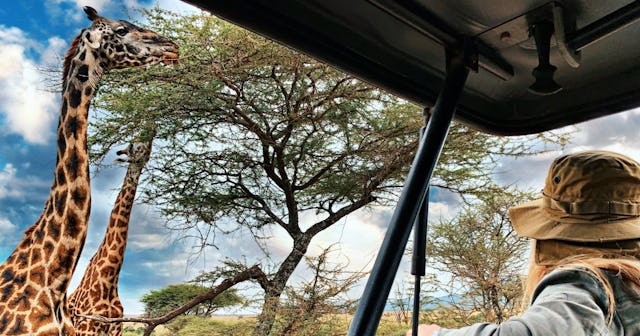Stretch Your Kid's Imagination By Introducing These 15+ Long-Neck Animals
Giraffes aren't the only ones.

The animal kingdom is full of odd creatures. From big feet and tiny heads to just, well, any bird beak, sometimes looking at animals can be downright laughable. We love giraffes, but you can sure as heck bet we make plenty of giraffe jokes at their expense. How can you not laugh at those long necks? Of course, giraffes are far from the only long-neck animals on our planet. As a matter of fact, animals with long necks have existed since before humans. There are several species of dinosaurs that have longer necks than even giraffes!
So, which animals have long necks, how long are they, and what are they used for? You can probably guess that, in most cases, these animals have evolved their long necks to aid in their safety as well as feeding. Keep reading for some stats long on fun, and feel free to break these facts out around the dinner table. They make fantastic conversation starters, especially for kids who typically like to respond with one-word answers.
Mammals With Long Necks
Giraffes
Anton Petrus/Getty Images
Neck Length: Up to 8 feet
Giraffes are herbivores who like to eat mostly leaves. For that reason, it seems they evolved their long necks to help reach food higher up in trees.
Dromedary Camels
Edwin Remsberg/Getty Images
Neck Length: Between 6-7 feet
A full-grown dromedary camel can grow about 10 feet tall and has exceptionally long legs. They use their necks to feed from the ground without sitting or kneeling, thus keeping them safe from predators.
Llamas
Westend61/Getty Images
Neck Length: About 4 feet long
While llamas may look more like the next animals on our list, they actually developed their long necks for the same reason as their camelid cousins. They, too, have rather long limbs and their long necks help them forage on the ground for food without needing to lower the rest of their bodies.
Alpacas
Photographer Renzi Tommaso/Getty Images
Neck Length: 3.8 feet
It’s believed alpacas evolved their long necks for two reasons. First, it helps them have a better view of their surroundings so that they can keep a lookout for their biggest predator: mountain lions. Their long necks also enable them to reach leaves that grow higher on trees.
Gerenuks (Waller’s Gazelle)
© Santiago Urquijo/Getty Images
Neck Length: About 1 foot
Gazelles often fall prey to larger, faster animals. These herbivores use their long, graceful necks to “keep their heads on a swivel” and look out for predators.
Birds With Long Necks
Ostriches
Manuel Romaris/Getty Images
Neck Length: About 3 feet
You probably already know that ostriches use their long necks to forage for food on the ground and, yes, bury their heads in the sand.
Whooper Swan
Jeremy Woodhouse/Getty Images
Neck Length: Approximately 3 feet
Whoopers swans are herbivorous birds whose necks are typically more than half as long as the rest of their body. Their long necks help them find food on water and on land.
Flamingos
Andres Ruggeri/EyeEm/Getty Images
Neck Length: 2.6 feet
Flamingos have 19 “cervical” vertebrae that allow them to contort their necks in various manners to aid in hunting, foraging, eating, and cleaning themselves.
Herons
Mark L Stanley/Getty Images
Neck Length: 2.5 feet
Herons may average slightly shorter necks than flamingos, but that doesn’t put them at a disadvantage. They have the same cervical vertebrae as flamingos — plus three more, for a total of 22 vertebrae.
Jabiru
Alex Tsarfin/Getty Images
Neck Length: 2 feet
“Jabiru” actually translates to “swollen neck,” and it’s because of that feature that jabiru birds are often overlooked when considering long-neck animals. That stocky neck just doesn’t look as elongated as the necks of flamingos or swans.
Rheas
Tobias Raddau/Getty Images
Neck Length: .9 feet
Closely related to both ostriches and emus, the rhea is a flightless bird that uses its long neck to find food.
Scarlet Ibis
yasmina saoudi/Getty Images
Neck Length: .7 feet
These wading birds use their long necks and curved bills to forage for food in shallow waters and muddy shores
Anhinga
yasmina saoudi/Getty Images
Neck Length: 3 feet
The anhinga has many names like snakebird, darter, water turkey, and devil bird. But its stretched neck isn't the only unique thing about this creature. Anhingas eat baby alligators! Fish, crayfish, shrimp, water snakes, and other aquatic bugs are also part of their diet. Anhingas are called snakebirds because they keep their necks on the water's surface as they swim, like snakes. You can find anhingas in fresh and saltwater habitats.
Other Long-Neck Animals
Snake-Necked Turtles
Hal Beral/Getty Images
Neck Length: .6 feet
What a peculiar-looking creature, right? These turtles’ strange necks stretch up to 60 percent longer than their shells.
Komodo Dragons
jayk7/Getty Images
Neck Length: Approximately 1 foot
*Shudder* These creepy guys not only have long necks that help with hunting and feeding, but they’re also venomous. Do not try to slay this dragon.
Long-Neck Dinosaurs
Sauropods
Mjrodafotografia/Getty Images
Neck Length: 50 feet!
Sauropods make up a species of dinosaur that includes the Brachiosaurus, Apatosaurus, and Diplodocus. One of the biggest sauropods was the Supersaurus. Superauruses had necks that were roughly 50 feet long!
Plesiosaurus
Mohamad Haghani/Stocktrek Images
Neck Length: More than 20 feet
These were swimming dinos that may have looked like the fabled Loch Ness Monster. Wondering how dinos could possibly hold up a 50-foot neck? To begin, Sauropods had up to 19 vertebrae in their neck, comparable to just the seven in a giraffe’s neck. Paleontologists have also found that Sauropods’ neck bones weighed significantly less than most bones because they were hollow, like a bird’s.
This article was originally published on